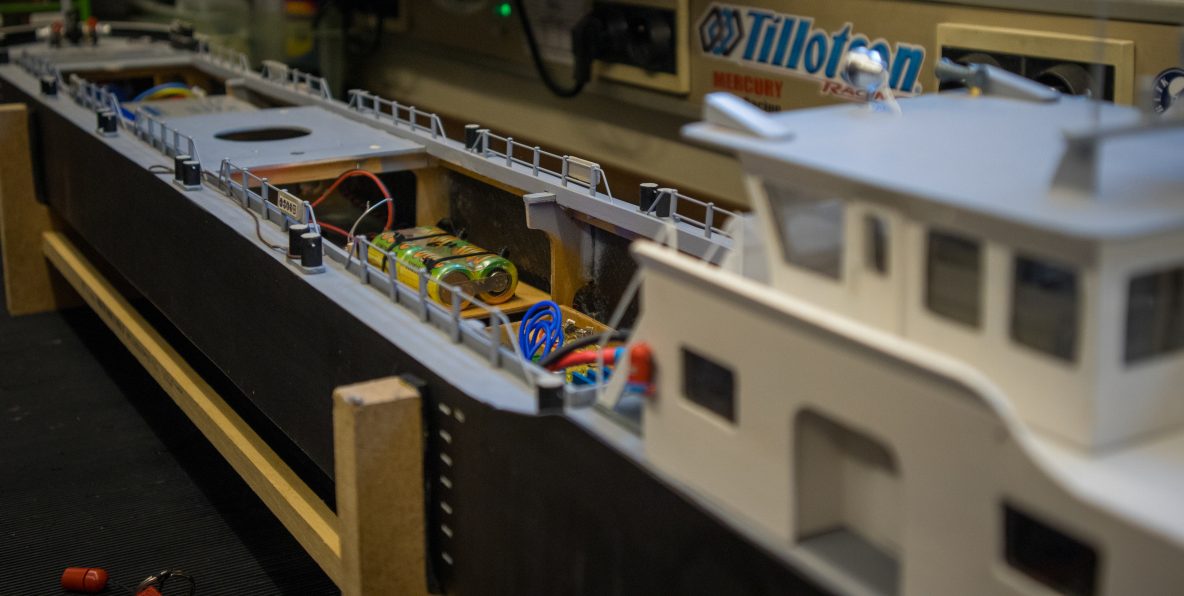It’s the middle of December. The wind is howling, and the lakes are frozen. While the cold weather puts a stop to the boat racing season, it finds Danny and Herman in their atelier.

Nautic model racing is a captivating hobby at the intersection of craftsmanship and competition. It brings together enthusiasts who construct miniature watercraft powered by electric motors or wind. Danny and Herman, two key figures in the Belgian scene, have known each other for many years now, sharing the same passion for even longer. The two of them find peace and excitement in the world of model boats.
Danny and Herman started this hobby, driven by an interest in mechanical engineering. Nearly five decades ago, Danny impressed many with his high school project, where he had to create a radio-controlled transmitter and receiver. Not knowing this would spark his lifelong interest, he chose a boat as his demonstration vessel. When Herman was younger, he stumbled upon a model shop in Ghent, initially giving it little thought. Years later, when his brother-in-law presented a catalogue, without hesitation, he pointed to the boat he had once dreamed of owning. They have been on this journey ever since. “For us, it comes naturally. He is an engineer; I am an electrician. We are into this stuff”, says Herman.

From March to September, clubs transform lakes into arenas for miniature regattas. Beyond the Belgian landscape, a global community resides. An annual world championship unites over 600 candidates from all over the world. Danny describes it as the Olympics. “It’s an opening day where all countries celebrate the upcoming tournaments. The clubs march the streets with their flags in preparation for what’s coming.” The races, a spectacle of synchronised vessels reaching speeds of up to 90 kilometres an hour, demand close collaboration between the mechanic and pilot to prevent crashes with other boats. Over the years, all hobbyists have become familiar with one another, building a friend-like community to return to. “We are one big family”, says Herman with a smile.
The global scale of the tournaments necessitates extensive travel. During the sailing season, Danny and his club participate in up to 20 races, bringing their family members along on their trips. “Your family has to enjoy it. Otherwise, it doesn’t work”, Herman elaborates. While Danny’s daughter has outgrown the love for racing after marriage, his wife transitioned from enthusiast to race judge, once even disqualifying him in a world championship. “I didn’t speak to her for three days!” Danny exclaims laughingly. He travels the world in a caravan with his wife and clubmates, turning every event into a celebration. These competitions encapsulate the moment when it all comes together: the investments, the time spent—nothing can beat the feeling.

In the realm of nautical model sailing, a boat is an essential requirement. Crafting the boats plays a significant role in shaping the hobby. Danny and Herman’s atelier is home to memories of over 45 years. Constricted by the space, boats are carefully stacked on shelves, fighting for a spot. “I don’t have any room left!” Danny says laughingly. “Crafting the boats requires a long process and dedicated investments”, Herman explains. When starting a new project, Herman and Danny first have to do research, asking themselves how the boat was made, with which materials, and which mechanics were used. Danny brings out a catalogue showing the inspiration for a boat and another one revealing the in-depth research they had conducted before embarking on the adventure. “I like looking at how they were built and how they look. Most of all, I like creating”, Danny adds while closing the catalogue. Their attention to detail extends beyond mechanics, leading them to decorate the ship with model-sized characters and accessories. Finding every little detail is like a scavenger hunt. “In the beginning, you can only make a boat that can go forward and backwards. But then you learn how to make it go left and right, and afterwards, when you learn more, you get to play around with lights, radars, and even water cannons”, Herman explains excitedly.
Until last year, Danny always sailed gasoline-driven boats. Despite his love for them, the shift towards electric boats was a necessity. Gasoline-powered boats can weigh up to 15 kilos. “As I got older, this became an impracticality”, Danny explains. Electricity-run boats are also cheaper and less noisy. “One race can cost you about 40 euros in gasoline. During tournaments, you often race in two or three different classes, which adds up to about 320 euros on fuel.” The hobby in itself requires an extensive financial commitment, costing up to 4,000 euros to embark on your journey.

For the last fifteen years, Danny and his fellow club mates have called Lochristi their home. Here, they navigate the waters of a windsurfing lake in harmony with the local windsurfers. “Every year, we pay the same amount of money to be a surf club member. But we don’t surf because we can’t surf; we do the boats”, Danny explains jokingly. Despite recognizing the evolving interests among younger generations, Danny and Hermann maintain a positive outlook on the hobby’s future. Danny reflects, “I think younger people prefer playing PlayStation. They don’t like doing things with their hands, doing things by themselves.” Despite their hopeful aspirations for a resurgence, Herman elaborates, “25 years ago, the Belgian Federation for Mobile boats counted 800 members; now it’s only 78.” The shifting landscape and increased costs may pose hurdles, but the recent addition of a new member to the Nautic Model Hobby Club brings a sense of optimism. In light of this, the club warmly embodies a hopeful spirit encouraging others to join their passion-filled community. “Even you can come!” they enthusiastically declare.
Authors: Ayla Onsea and Thea Chisalita
[jetpack-related-posts]
